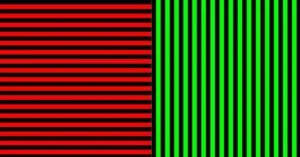The McCollough Effect
This illusion, known as the McCollough Effect, tricks the mind. Staring at a colored grating for several minutes causes the brain to perceive a pink tinge or other colors when viewing black and white stripes. Tilting your head 90 degrees can alter the effect, and rotating the induction images can reverse it. The more you view the induction images, the longer the effect lasts.
Understanding Afterimages
This visual illusion is called an afterimage because the sight persists even after removing the stimulus. Scientists believe this results from continued activation of the visual system. Strong colors leave a lasting impression, tricking the visual system into believing the colors are still there.

Real-World Examples
The same phenomenon occurs when a camera flash lingers in your vision after you close your eyes. According to the Journal of Experimental Psychology, the effect can last over three months if a person looks at colorful gratings for an extended period. US psychologist Celeste McCollough Howard, who discovered this effect, called it the ‘contingent aftereffect.’

Color Afterimages
Researchers proved that red and green stripes produce an afterimage. If the induction image is green, viewers see red on vertical grates and green on horizontal grates. With a red induction image, the colors reverse. Only red and green can produce this effect. Be cautious with long durations to avoid eye strain.
Potential Dangers
The McCollough Effect involves staring at vertical and horizontal lines, which might alter your color perception for up to three and a half months. Some people find it fascinating, while others experience headaches after just five minutes. To reverse the effect, stare at the original colored images again for half the original time, rotating them 90 degrees counterclockwise.
